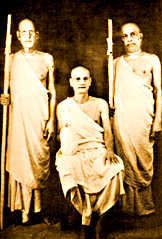The following is an excerpt from a talk given by Sripad Bhaktibhavana Visnu Maharaja on the occasion of Srila Prabhupada's Sannyasa initiation anniversary at Kesavaji Gaudiya Matha in Mathura.
 What is the significance of Sannyasa ? In Gaudiya Vaisnavism there are many important philosophical points to understand properly and digest. To make progress, devotees must refine their conception of divinity and focus their aspirations. The order of sannyasa is a strong step in that direction.
What is the significance of Sannyasa ? In Gaudiya Vaisnavism there are many important philosophical points to understand properly and digest. To make progress, devotees must refine their conception of divinity and focus their aspirations. The order of sannyasa is a strong step in that direction.
There is an external meaning and an internal meaning to the order of sannyasa. Formally, the order of sannyasa is to renounce the material world; it is considered social suicide. That is, we give up our connection with family and friends and social obligations and dedicate kayo, mana, vaca,and jiva -- our body, mind, words, and soul--to the service of the Lord. And, as the brahmana from Avantidesa said, aham tarisyami duranta-param, "I shall cross over the ocean of nescience and become firmly fixed, asthaya paratma-nistham, in the service of our Lord Mukunda."
This order exemplifies this determination, in that one is giving himself wholly for the service of the Lord -- but this determination is available to anyone willing to make a full commitment. This commitment is not necessarily formal, but substantially internal. As the Bhagavad-gita says, anasrita karma-phalam karyam karma karoti ya. If one simply renounces, he is not actually a sannyasi. Real renunciation, means to engage everything in the service of the Lord, nirbandha krsna-sambandhe yuktam vairagyam ucyate, and to fix one's aspiration with great determination.
 In the Vilapa-kusamanjali, verse 102 expresses the highest summit of devotion -- a sublimely sweet and reassuring hope. In this verse we find the inner ideal of sannyas and the purport of the sannyas mantra. Asabharair amrta-sindhu-mayai kathancit, kalo mayatigamita kila sampratam hi. Raghunatha Dasa's devotion is so exclusive to Srimati Radharani that he is saying that without her service he doesn't even care for Krsna. "It is shameless for me to say this, but I don't even want Vrndavana, I don't want Krsna. Your mercy is everything to me." This is the high aspiration of Raghunatha Dasa.
In the Vilapa-kusamanjali, verse 102 expresses the highest summit of devotion -- a sublimely sweet and reassuring hope. In this verse we find the inner ideal of sannyas and the purport of the sannyas mantra. Asabharair amrta-sindhu-mayai kathancit, kalo mayatigamita kila sampratam hi. Raghunatha Dasa's devotion is so exclusive to Srimati Radharani that he is saying that without her service he doesn't even care for Krsna. "It is shameless for me to say this, but I don't even want Vrndavana, I don't want Krsna. Your mercy is everything to me." This is the high aspiration of Raghunatha Dasa.
Most devotees are familiar with Raghunatha Dasa's vairagya, his renunciation. The Caitanya-Caritamrta mentions, raghunatathera niyama-yena pasanera rekha, that his renunciation was like lines in stone, so rigid his sadhana was every day. He is, however, substantially known as our prayojana-tattva acarya -- he is showing the highest ideal of Sri Chaitanya's followers. In these prayers, he has expressed this yearning -- absolute dependence, complete dedication to the service of Srimati Radharani. This also should be the aspiration, the ideal, of those devotees who are advancing in Gaudiya Vaisnavism. This is the line of Sri Rupa; this is our wonderful prospect.
When Sri Chaitanya Mahaprabhu received the sannyas mantra from Kesava Bharati, he first whispered the mantra into the ear of Kesava Bharati. He said, "Is this the mantra that you will give me? I have heard it in a dream, 'tat tvam asi. '" The common understanding of this mantra is "you are that" (you are Brahman ). Murari Gupta revealed to Sri Chaitanya Mahaprabhu another, more acceptable meaning of this mantra, which Chaitanya Mahaprabhu in turn gave to Kesava Bharati: "You are his." It is considered that at that time Sri Chaitanya initiated his spiritual master into the Vaisnava conception of this mantra and then received the mantra back.
For Chaitanya Mahaprabhu, it is proper to say that "I am his; I am Krsna's." The meaning of the mantra that sannyasis coming from Sanatana Goswami receive, however, is "I am hers; I am Srimati Radharani's. I exclusively engage myself in the service of Srimati Radharani." Actually, she is the highest devotee--she is the only one who can please Krsna, aradhananam sarvesam, all bhakti goes through Srimati Radharani. She is tadiya, most dear to Krsna. In that way we should see everything.
Certainly our Srila Prabhupada has shown this. So dear he is to Srimati Radharani. He has spread Krsna consciousness all over the world and brought so many to her lotus feet -- so many servitors to assist in her service to Krsna. This is the most confidential service. Rasa lila is sankirtana lila -- the lila of Chaitanya Mahaprabhu. Gaura lila is nondifferent than Krsna lila. But Gaura lila can be said to be higher in that it is more magnanimous; it is being distributed--audarya. Mahaprabhu is giving out this ecstatic ocean of Krsna-prema. He is experiencing at every moment the great ecstasy of the love of Radha and Krsna, prema pum-artho mahan. This is the highest level of devotion.
And it is said, ramya kacid upasana vraja-vadhu-vargena, the worship shown by the gopis of Vrndavana is the highest, because they gave up everything, renounced everything. They didn't care for their families; they didn't care for their personal happiness at all. They simply were interested in pleasing Krsna. When they met Krsna in Kuruksetra after so long, they were very happy to see him. They pleaded, "Actually, we are only simple village girls with cows as our wealth; we have no qualification; we only know family life; we have not done any austerities; we don't know the Vedas; we are not anyone special. We are not yogis who will be satisfied simply to meditate upon you, but we would like to live with you as Your family." In that way they are humbly approaching Krsna. Krsna considered how fortunate he was to have the gopis'wonderful affection. Krsna was feeling so guilty at having neglected such perfect love for so long that he bent down to touch Srimati Radharani's lotus feet. And she said, "No. No. That is not proper. Actually, I am at fault. You have not done anything wrong."
In the same way, Chaitanya Mahaprabhu has said, na prema-gandho 'sti darapi me harau, "The proof that I have no love for Krsna is that I have not left my body in separation, that I go on living." So, in this way, Srimati Radharani is feeling that the fault is hers, "You are free to move as you like." She is exemplifying this extreme mood of devotion. This is saranagati -- surrender. In a higher sense, another term could be used, atmaniksepa. This means to throw oneself desperately toward the lotus feet of the Lord, "I am Yours to be used in Your service as you like, as you see fit." Aslisya va pada-ratam pinastu mam adarsanan marma-hatam karotu va, if you like you may embrace me or if you like you may trample me, but use me as you like.
This is the symptom of the surrendered souls, that they are ready to be used by the Lord in any way. Srila Prabhupada wrote in his arrival prayer, "naco gao -- As you wish me to dance, I shall dance. And if you don't wish me to dance, I won't dance. It is your choice, my Lord, I am yours to be used in your service." The renouncedorder, both its external and internal significance, was thus epitomized in Srila Prabhupada. He preached widely and internally fully embraced the service of Sri Radhika. He renounced the world and became the servitor of Sri Dayita dasa (Srila Bhaktisiddhanta Saraswati).